Montenegro, a captivating destination along the Adriatic coast, offers a unique blend of historical richness, natural beauty, and modern luxury. This comprehensive guide for 2024 will take you through everything from travel logistics to the must-visit places and everything you need for an unforgettable stay.

ARRIVING IN MONTENEGRO: YOUR GATEWAY TO THE ADRIATIC
Montenegro, with its stunning coastline and picturesque landscapes, is conveniently accessible from various parts of the world. Whether you’re flying in from afar or traversing the scenic landscapes of Europe by road or rail, Montenegro welcomes travelers with both its beauty and accessibility.
Air Travel to Montenegro
Montenegro’s main gateways by air are Podgorica Airport and Tivat Airport. These airports connect Montenegro to the global stage with several direct flights from major cities in Western Europe, the United States, and the United Arab Emirates.
- – Podgorica Airport (TGD): Located in the capital city, Podgorica Airport is the larger of the two and serves as a hub for international and domestic flights. Airlines here connect passengers to key European cities such as London, Paris, Frankfurt, and Moscow, as well as providing seasonal links to the Middle East.
- – Tivat Airport (TIV): Situated near the coastal town of Tivat, this airport is especially popular during the summer months when the demand for seaside vacations peaks. It’s particularly favored by tourists looking to visit the Bay of Kotor or the luxurious marinas and resorts in the vicinity, including Lustica Bay.
Both airports are equipped with car rental services, taxis, and bus connections, making it easy to reach your final destination in Montenegro upon arrival.
Overland Travel to Montenegro
For those who prefer a road trip, Montenegro is well-connected by highways and roads that cross picturesque terrains, offering a visual treat before even reaching your destination. Here are some popular routes:
- – From Croatia: Driving from Dubrovnik to Montenegro is one of the most common routes for travelers coming from Croatia. The drive down the Adriatic coast is renowned for its breathtaking views and takes you directly to the Montenegrin coastal towns like Herceg Novi and Kotor.
- – From Serbia: The Belgrade-Bar highway is a popular overland route for those traveling from Serbia. This route offers a dramatic change in scenery from rolling hills to mountainous terrains as you enter Montenegro.
- – From Albania: The route from Tirana to Podgorica provides another scenic journey, passing through mountains and lakes, reflecting Albania and Montenegro’s shared natural beauty.
Rail and Sea Options
Montenegro is also reachable by train and sea, which provide alternative scenic routes into the country:
- – By Rail: The rail service from Belgrade to Bar is not just a means of transport but an experience in itself, featuring 254 tunnels and 435 bridges, including the Mala Rijeka viaduct, one of the highest railway viaducts in the world.
- – By Sea: The ports of Bar, Budva, Kotor, and Tivat welcome numerous cruise ships and private yachts each year. The Bay of Kotor, a fjord-like bay, is particularly popular among sailors and cruise passengers who are greeted by the medieval architecture and dramatic mountain backdrop as they sail in.
EXPLORING MONTENEGRO: GEOGRAPHY AND CLIMATE
Montenegro’s unique position in Southeast Europe, bordered by Croatia, Bosnia, Albania, Serbia, and Kosovo, gifts it with a diverse geographical landscape that ranges from picturesque beaches to rugged mountains. This varied topography not only shapes the country’s natural beauty but also its climate, which changes noticeably from the coast to the interior.

Coastal Regions
The coastal strip of Montenegro, which stretches along the Adriatic Sea, is blessed with a Mediterranean climate. This zone includes popular tourist destinations such as Budva, Kotor, and the emerging marina town of Lustica Bay. Here, summers are typically hot and dry, making it an ideal season for beachgoers and sun-seekers. Temperatures during these months frequently reach the mid-30°C (around 85°F), providing perfect conditions for swimming and water sports.
Winters along the coast are mild and wet, with temperatures rarely falling below 5°C (about 41°F). This milder weather allows for year-round tourism, with winter visitors enjoying fewer crowds and still pleasant days, ideal for exploring historic towns or enjoying leisurely walks along the seafront.
Interior Highlands
In contrast, the interior of Montenegro, particularly the northern highlands, experiences an alpine climate. This region includes some of Montenegro’s most spectacular national parks such as Durmitor, Biogradska Gora, and Prokletije. These areas are characterized by cooler temperatures and receive more precipitation, which can fall as heavy snow in the winter months.
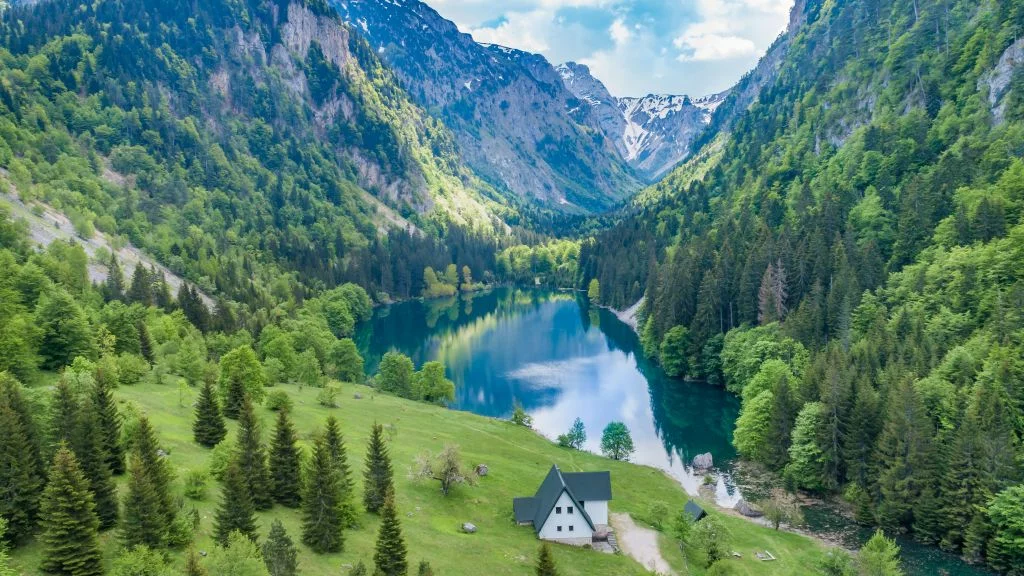
Winter temperatures in these areas can drop well below freezing, transforming the landscape into a winter wonderland perfect for skiing, snowboarding, and other winter sports. The ski resorts in Kolašin and Žabljak become bustling hubs of activity in the winter, attracting enthusiasts from across Europe.
Summer in the highlands offers a stark contrast to the coastal experience. Temperatures are generally cooler, making it an ideal refuge from the scorching heat of the Adriatic coast. These months are perfect for hiking, mountain biking, and exploring the deep forests and glacial lakes that dot the landscape.
Transitional Zones
Between the coastal areas and the northern highlands lie transitional zones that feature a mix of these two primary climates. These areas, which include cities like Podgorica and the Lake Skadar region, experience hot summers but with more rainfall than the coast, and cooler, wetter winters than the Mediterranean regions but less severe than in the highlands.
Climate Considerations for Travelers
For travelers, Montenegro’s varied climates mean that activities can be highly seasonal, but also that any time of year offers its own unique set of attractions:
- – Spring (March to May) is ideal for exploring the coastal and interior regions as the weather is mild and the natural world is in bloom.
- – Summer (June to August) is best for beach holidays and water-related activities on the coast, while the cooler mountain areas offer a break from the heat.
- – Autumn (September to November) provides beautiful foliage and excellent weather for outdoor adventures in both the mountains and along the coast.
- – Winter (December to February) is perfect for snow sports in the northern highlands and enjoying the quiet beauty of the coastal towns without the summer crowds.
Whether you’re drawn to the sun-warmed coast of the Adriatic or the snow-capped peaks of the Dinaric Alps, Montenegro’s geography and climate cater to every preference, making it a year-round destination for all types of travelers.
ICONIC CITIES AND REGIONS OF MONTENEGRO
Montenegro is a country of striking diversity, with each region offering unique experiences that cater to different interests — from historical explorations to luxury living by the sea. Here’s an insight into some of Montenegro’s most iconic cities and regions, each embodying the country’s rich historical tapestry and vibrant culture.
Budva: The Pulse of Montenegrin Tourism
Budva, one of the oldest settlements on the Adriatic Sea, with a history spanning over 2,500 years, seamlessly combines historical depth with modern vibrancy. It is a central attraction in Montenegro, known for:
- Medieval Old Town: Explore the charming cluster of narrow streets and squares, surrounded by ancient city walls. Historical sites like the Church of Saint John and the Citadel offer glimpses into the past while providing stunning views of the Adriatic.
- Beaches and Nightlife: Home to some of the most beautiful beaches in Montenegro, including Mogren, Jaz, and Slovenska Plaža. Budva transforms into a vibrant nightlife hub after sunset, with numerous bars, clubs, and cafes.
- Cultural Events: Throughout the summer, Budva hosts various cultural events, including music festivals like the Sea Dance Festival and theatrical performances within the old town.
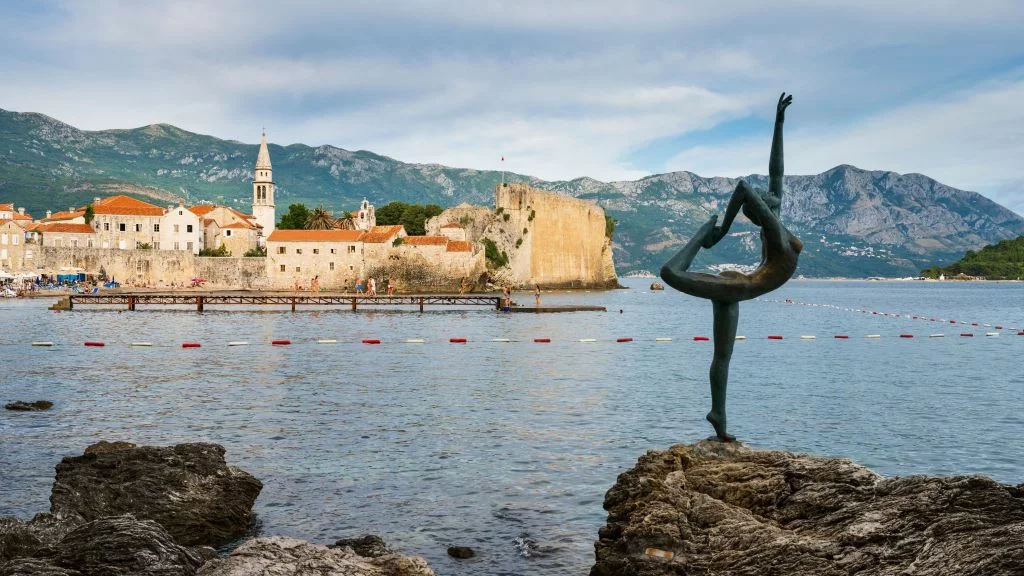
Cetinje: The Historical Heart of Montenegro
As the old royal capital, Cetinje is steeped in Montenegro’s history and culture, offering a reflective counterpoint to the bustling coastal towns.
- Cultural Institutions: Home to the National Museum of Montenegro and the King Nikola Museum. The city’s monasteries, including the Cetinje Monastery, hold significant religious and historical artifacts.
- Architectural Heritage: Streets lined with embassies and government buildings from when Cetinje was the capital of the Kingdom of Montenegro, many now serving as museums and galleries.
- Gateway to Lovćen National Park: A starting point for visitors to Lovćen National Park, where the Mausoleum of Njegoš offers panoramic views of Montenegro.
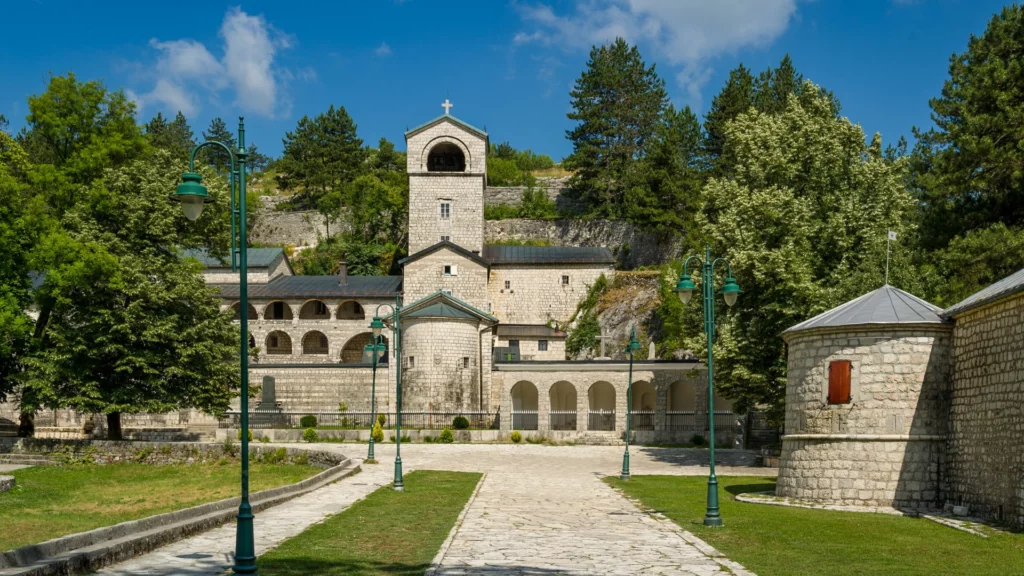
Kotor and Its Municipality: A Blend of History and Scenic Beauty
Kotor, a fortified town on Montenegro’s Adriatic coast, is famous for its stunning architecture and dramatic mountain backdrop. The town and its neighboring municipalities, including Perast, Risan, and Dobrota, are known for:
- UNESCO World Heritage Status: Kotor’s well-preserved medieval structures and its scenic bay place it on the map as a must-visit location.
- Perast and Risan: Known for their baroque architecture and ancient ruins, these towns offer a quiet escape with breathtaking views and rich history.
- Dobrota: Famous for its palaces and maritime heritage, Dobrota is integral to understanding the bay’s historical wealth.
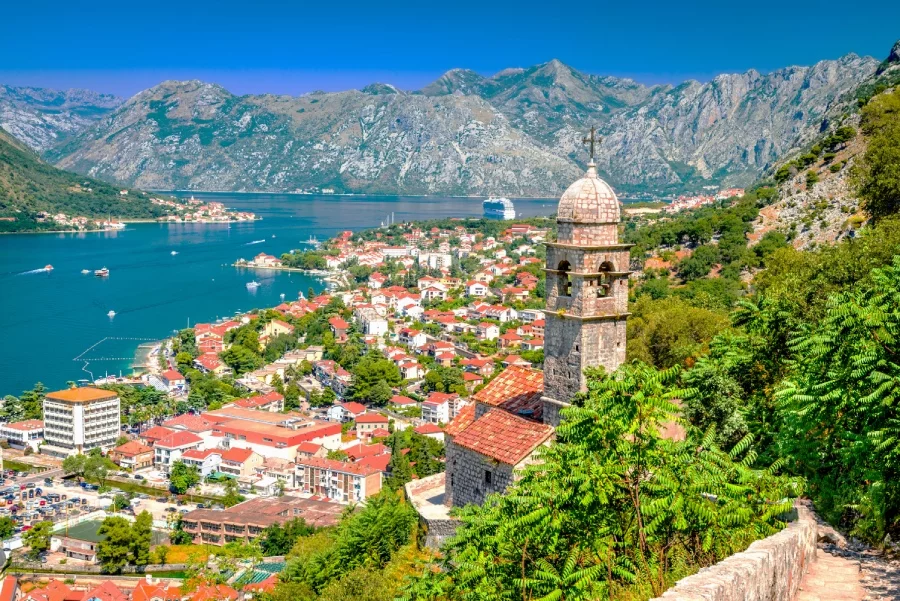
Bar Riviera: Gateway to the Adriatic
The Bar Riviera stretches along the coast, offering a mix of modernity and tradition with its port, train station, and old town.
- Hiking and Nature: Explore the trails and waterfalls of Rumija or discover hidden beach coves along the Riviera, perfect for adventurers and nature lovers.
- Cultural Sites: The old town of Bar, with its historical and architectural sites, provides a deep dive into Montenegro’s past.
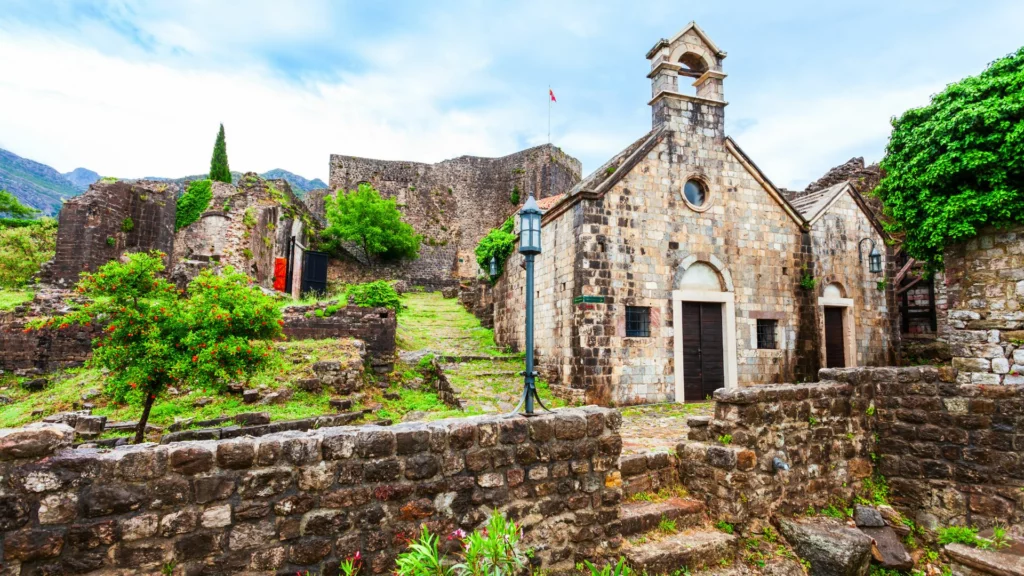
Ulcinj: A Blend of Cultural Influences
Ulcinj, known for its long sandy beaches and the vibrant Ada Bojana, offers a unique cultural tapestry influenced by various civilizations.
- Old Town: Explore the old town of Ulcinj, rich in history and characterized by its medieval architecture.
- Velika Plaza and Ada Bojana: Ideal for kitesurfing and relaxation, these areas are famous for their scenic beauty and recreational offerings.

EXPLORING NATIONAL PARKS OF MONTENEGRO
Montenegro’s national parks are a testament to the country’s immense natural beauty and biodiversity. Each park offers a unique environment and activities, making them must-visit destinations for nature lovers and adventure seekers alike.
Lovćen National Park
Lovćen National Park is located in the rocky region of the Dinaric Alps and centers around Mount Lovćen. The park is a symbol of Montenegrin national identity due to its historical, cultural, and spiritual significance.
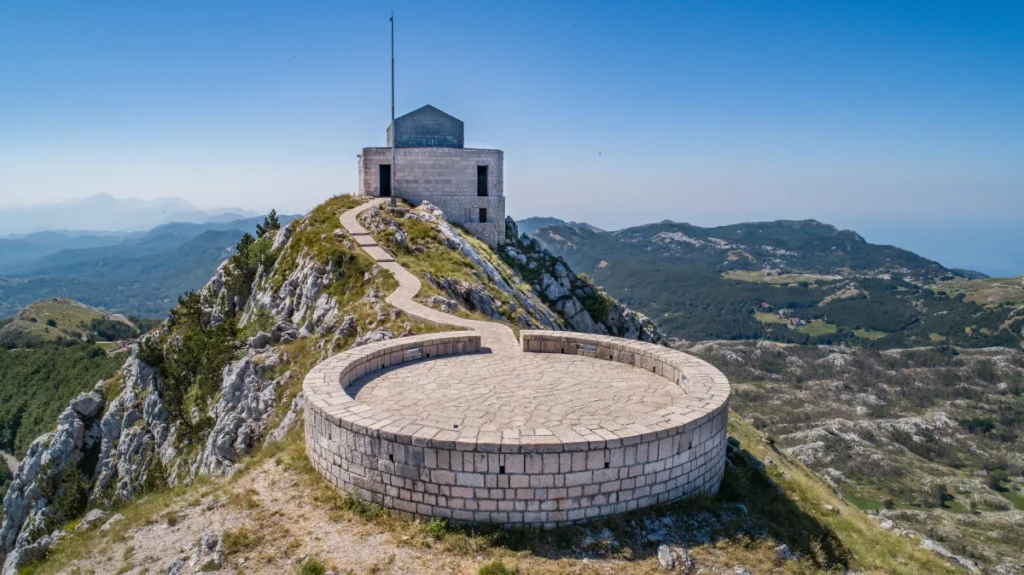
- – Mausoleum of Njegoš: At one of the park’s highest peaks sits the Mausoleum of Petar II Petrović-Njegoš, a revered Montenegrin ruler and poet. The site is accessible by a challenging climb of 461 steps, rewarding visitors with breathtaking panoramic views of Montenegro.
- – Biodiversity and Scenic Landscapes: The park’s landscape features a mix of rocky mountain terrain and green pastures, which are home to diverse flora and fauna. This variety of landscapes offers opportunities for hiking, picnicking, and photography.
- – Historical and Cultural Insights: Besides its natural beauty, the park also provides insight into Montenegro’s history through preserved traditional architecture like the historical village of Njeguši, the birthplace of Njegoš.
Lake Skadar National Park
Lake Skadar, shared by Montenegro and Albania, is the largest freshwater lake in Southern Europe and is renowned for its diverse ecosystem, particularly its birdlife.
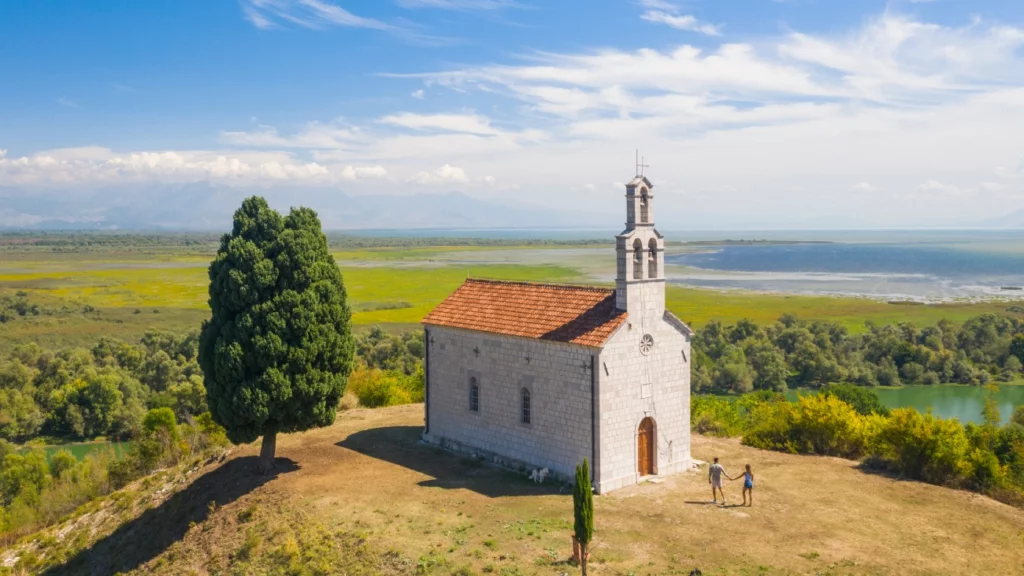
- – Bird Watching: The lake is one of Europe’s top bird-watching destinations, home to over 280 species including some of the last pelicans in Europe, making it a paradise for ornithologists and nature enthusiasts.
- – Boat Tours and Kayaking: Visitors can explore the lake by boat or kayak, navigating through a maze of floating water lilies and lush riverside vegetation.
- – Cultural Attractions: The lake’s vicinity is dotted with medieval monasteries and small fishing villages, offering a glimpse into the local way of life and Montenegro’s rich history.
Durmitor National Park
Durmitor is a UNESCO World Heritage site recognized for its magnificent natural landscapes, which include 48 peaks above 2,000 meters, 18 glacial lakes, and the Tara River Canyon.
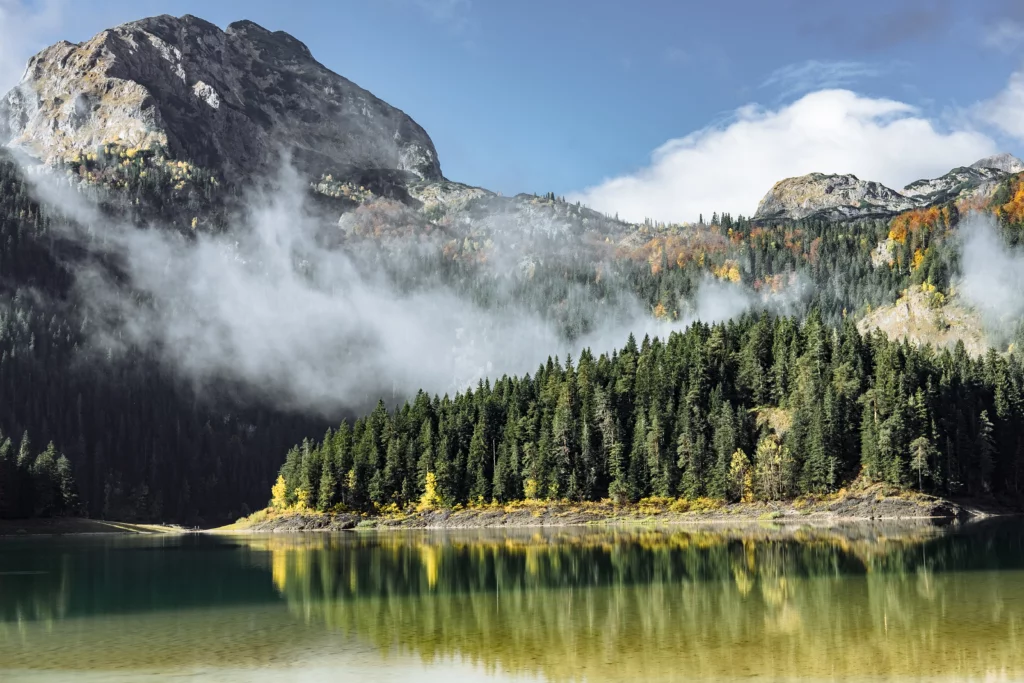
- – Adventure Sports: The park’s rugged terrain makes it a popular spot for adventure sports such as mountaineering, hiking, and white-water rafting on the Tara River, known for having the deepest river canyon in Europe.
- – Skiing and Snowboarding: In winter, Durmitor transforms into a popular ski destination, with snow-covered slopes that are perfect for skiing and snowboarding.
- – Eco-Tourism: Durmitor is committed to sustainable tourism practices, offering visitors eco-friendly accommodations and activities that emphasize conservation and respect for nature.
Biogradska Gora National Park
Biogradska Gora boasts one of the last three large virgin forests in Europe, with trees that are over 500 years old, undisturbed by modern development.

- – Untouched Wilderness: The park offers a rare opportunity to experience untouched nature. Trails lead through dense forests to clearings and glacial lakes, providing a tranquil escape from the modern world.
- – Outdoor Activities: Popular activities include hiking, mountain biking, and boating on Biogradsko Lake, the park’s largest lake.
- – Cultural Experience: The park also features traditional katuns, seasonal shepherd’s homes, which provide insight into Montenegro’s pastoral culture.
Prokletije National Park
Known colloquially as the ‘Accursed Mountains’, Prokletije is the most rugged and wild of Montenegro’s national parks, appealing especially to those seeking solitude and adventure.
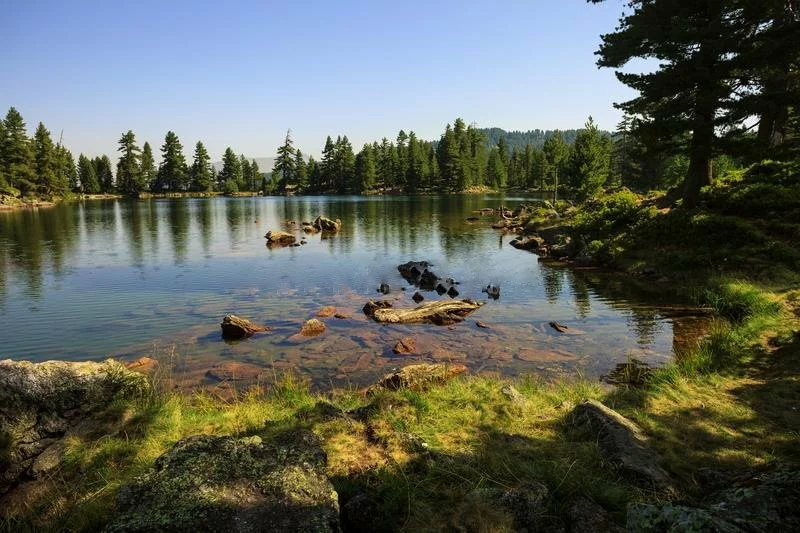
- – Challenging Terrain: The park features some of the most challenging hiking and climbing trails in the Balkans, offering thrilling adventures for experienced hikers and climbers.
- – Breathtaking Scenery: The landscape is characterized by sharp peaks, deep valleys, and pristine rivers, creating dramatic views that are a photographer’s dream.
- – Flora and Fauna: Despite the harsh terrain, the park is rich in biodiversity, hosting rare species of plants and wildlife, contributing to its status as a significant ecological haven.
CULTURAL AND RECREATIONAL ACTIVITIES IN MONTENEGRO
Montenegro is a treasure trove of both cultural richness and outdoor excitement. Its unique geographical layout, from the sun-drenched Adriatic coast to its rugged northern mountains, ensures a wide array of activities tailored to different tastes and interests. Whether you’re soaking up the sun on a plush beach or delving into the historic streets of ancient towns, Montenegro delivers unforgettable experiences.
Coastal Leisure and Water Sports
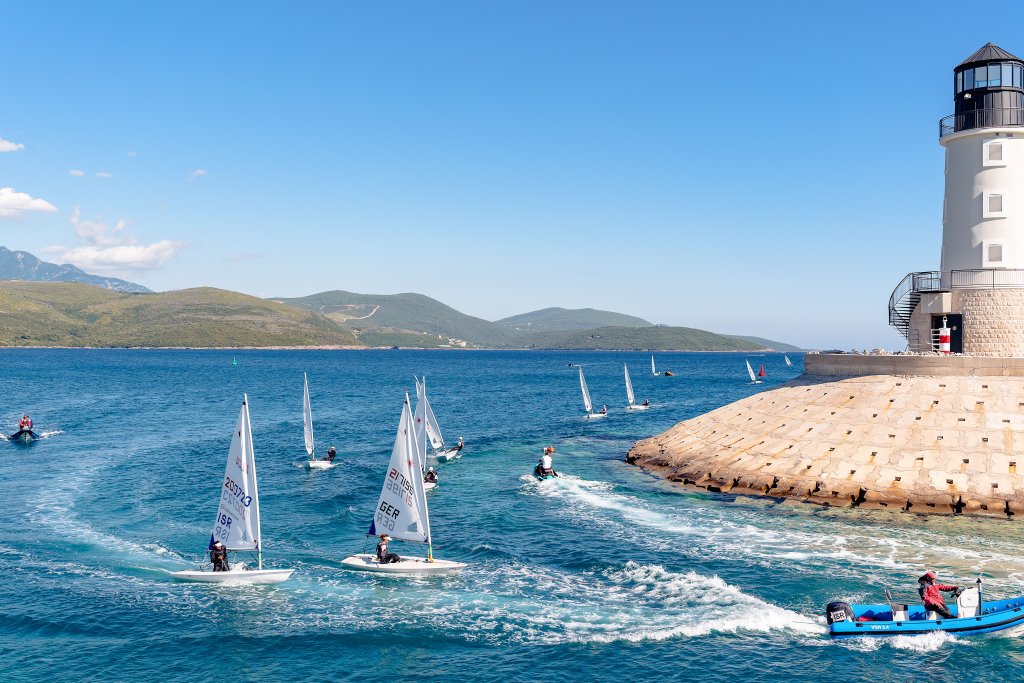
- – Sailing and Yachting: The Adriatic coast of Montenegro, with well-equipped marinas like Porto Montenegro in Tivat, is a haven for sailing enthusiasts. The calm waters and scenic coastline provide perfect conditions for sailing adventures.
- – Beach Lounging: Montenegro’s beaches, from the popular sands of Budva’s Jaz Beach to the more secluded beaches of the Lustica Peninsula, offer everything from vibrant beach bars to quiet retreats. Each beach has its charm and character, whether it’s the bustling beach parties of Budva or the tranquil bays near Petrovac.
- – Water Sports: For the more adventurous, the Montenegrin coast offers a plethora of water sports, including jet skiing, kayaking, and parasailing. The clear blue waters of the Adriatic are ideal for scuba diving and snorkeling, revealing a rich underwater world.
Cultural Exploration
- – Historic Town Tours: Montenegro’s history can be explored in its well-preserved old towns. Kotor, with its UNESCO-protected medieval old town, and the royal capital of Cetinje are steeped in history and culture, featuring ancient palaces, monasteries, and museums.
- – Cultural Festivals: Montenegro hosts a variety of cultural festivals throughout the year that showcase its rich heritage and contemporary art scene. The KotorArt International Theater Festival and Budva’s City Theatre are highlights, offering performances in spectacular historic settings.
- – Culinary Experiences: Montenegrin cuisine reflects its geographic diversity. Coastal towns offer fresh seafood dishes, while mountain regions serve hearty traditional meals like kacamak (polenta with cheese) and jagnjetina (roasted lamb). Wine tours and olive oil tastings provide insights into the local agricultural practices and traditions.

Adventure and Nature Activities
- – Hiking and Mountain Biking: The northern regions of Montenegro offer rugged landscapes ideal for hiking and mountain biking. National parks like Durmitor and Prokletije offer marked trails that range from easy walks to challenging treks.
- – Adventure Sports: For thrill-seekers, Montenegro’s rivers and canyons offer white-water rafting, particularly the Tara River Canyon, known for some of the best rafting in Europe. Zip-lining across the canyon is another way to experience its breathtaking scenery.
- – Skiing and Winter Sports: During the winter months, Montenegro’s mountainous north transforms into a snowy wonderland. Ski resorts like Kolašin 1450 and Savin Kuk in Durmitor cater to all levels of skiers and snowboarders, providing a quieter alternative to the more crowded Alps.
Relaxation and Wellness
- – Spa and Wellness: Many of Montenegro’s luxury hotels and resorts, particularly in areas like Lustica Bay and Sveti Stefan, offer spa and wellness facilities. These services range from traditional massages and treatments using local herbs to modern wellness therapies, providing perfect relaxation after a day of activities.
- – Yoga and Retreats: The serene environment and natural beauty of Montenegro make it an ideal spot for yoga and wellness retreats. The peaceful ambiance of the coast or the refreshing air of the mountains offers a rejuvenating backdrop for meditation and health-focused retreats.
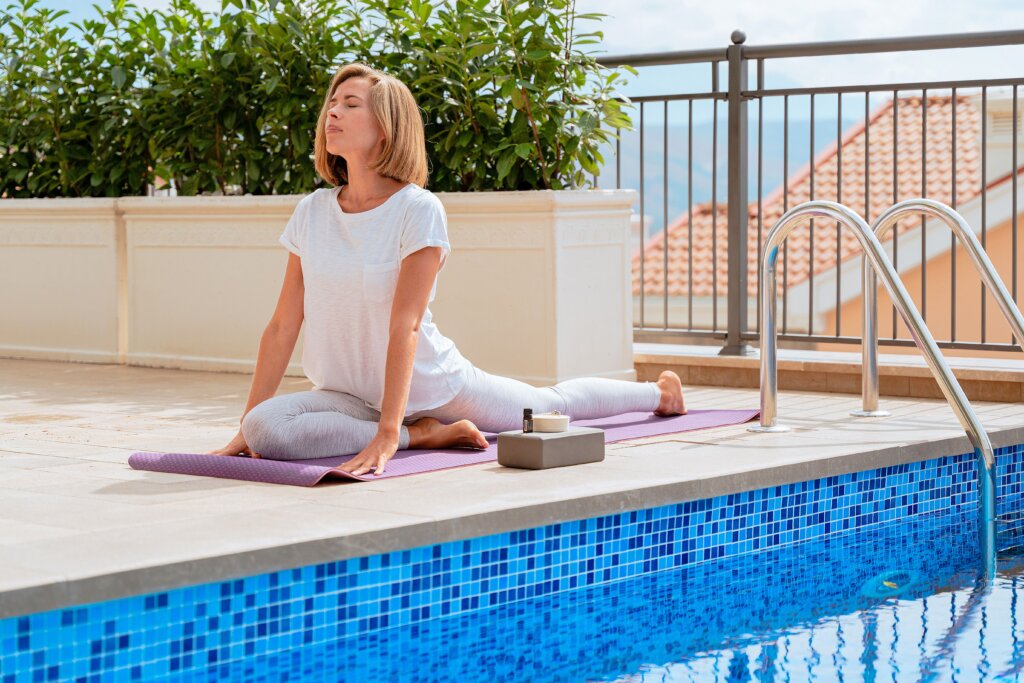
BEST TIME TO VISIT MONTENEGRO: WEATHER, ACTIVITIES, AND TRAVEL TIPS
Choosing the right time to visit Montenegro involves considering the weather, what activities are available, and what you should pack. Here’s a detailed guide to help you decide when to plan your trip, featuring typical temperature ranges and suggested attire for each season.
Summer (June to August): Peak Season for Sun Seekers
- – Weather: Temperatures range from 25°C to 35°C (77°F to 95°F), with the coastal areas enjoying warm, sunny days ideal for beach activities.
- – Activities: The summer months are perfect for swimming, sailing, and exploring the vibrant nightlife and festivals along the coast. Beaches are lively, and water sports are abundant.
- – What to Wear: Pack light clothing, swimsuits, sunglasses, a wide-brimmed hat, and sunscreen. Evenings can be warm, so light layers are often sufficient.
Autumn (September to November): Cultural Exploration and Natural Beauty
- – Weather: Temperatures range from 25°C to 35°C (77°F to 95°F), with the coastal areas enjoying warm, sunny days ideal for beach activities.
- – Activities: The summer months are perfect for swimming, sailing, and exploring the vibrant nightlife and festivals along the coast. Beaches are lively, and water sports are abundant.
- – What to Wear: Pack light clothing, swimsuits, sunglasses, a wide-brimmed hat, and sunscreen. Evenings can be warm, so light layers are often sufficient.
Winter (December to February): A Wonderland for Snow Lovers
- – Weather: In the northern regions, temperatures can drop below 0°C (32°F), especially in mountainous areas. Coastal areas have milder winters with temperatures ranging from 5°C to 15°C (41°F to 59°F).
- – Activities: Skiing, snowboarding, and enjoying the scenic snowy landscapes are popular in places like Kolašin and Žabljak. Coastal towns are quieter but offer serene winter walks and festive activities.
- – What to Wear: Heavy winter clothing is necessary, especially in the north. Include thermal layers, a heavy coat, waterproof boots, and warm accessories like gloves and hats.
Spring (March to May): Ideal for Outdoor Enthusiasts and Nature Lovers
- – Weather: Spring sees a gradual warming with temperatures typically between 10°C and 20°C (50°F to 68°F). The season starts cool and warms up as summer approaches, with occasional rain showers.
- – Activities: This is the best time for hiking, cycling, and exploring the lush greenery and blooming landscapes. It’s also perfect for bird watching and photography.
- – What to Wear: Dress in layers to adapt to the changing conditions. Include light jackets, comfortable walking shoes, and waterproof gear for unexpected showers.
UNDERSTANDING VISA REQUIREMENTS FOR MONTENEGRO
Montenegro’s visa regulations are relatively straightforward, making it a convenient destination for tourists from many countries. Here’s what you need to know about entering Montenegro, particularly if you are traveling from the US, UK, UAE, or Western Europe.
Visa-Free Entry
- – Eligibility: Tourists from the US, UK, UAE, and most Western European countries can enjoy visa-free entry to Montenegro.
- – Duration of Stay: You can stay in Montenegro without a visa for up to 90 days within a 180-day period. This is ideal for both short visits and longer vacations.
- – Purpose of Visit: The visa-free access generally covers tourism, business meetings, and visiting friends or family. If you plan to work or study, different rules may apply, requiring a specific visa or permit.
Additional Considerations
- – Passport Validity: Ensure your passport is valid for at least three months beyond your planned departure date from Montenegro. Some countries might require a longer validity period.
- – Proof of Travel: It’s advisable to have proof of return or onward travel, as well as sufficient funds for your stay. Occasionally, border officials may request to see travel insurance that covers your time in Montenegro.
- – Staying Longer: If you wish to stay longer than 90 days, you will need to apply for a temporary residence permit. This application should be submitted to the relevant Montenegrin authorities before your visa-free period expires.
- – Work or Study: For activities like employment or education that extend beyond the scope of tourism or short business visits, contact the nearest Montenegrin embassy or consulate for specific visa requirements.
Regularly Check for Updates
- – Changing Regulations: Visa policies and entry requirements can change. Always check the official Montenegrin Ministry of Foreign Affairs website or consult with the nearest Montenegrin embassy or consulate for the most current information before your trip. For specific details based on your country, visit Montenegro’s Diplomatic Missions page.
- – Health and Safety Regulations: Given the changing global health landscape, additional entry requirements (like vaccinations or health certifications) might be in place. Ensure you meet all health guidelines as stipulated by Montenegrin authorities.
LUŠTICA BAY: A COMPREHENSIVE LUXURY EXPERIENCE
Luštica Bay is more than just a luxury destination; it’s a dynamic community tailored to meet the needs and desires of its diverse visitors and residents. With a keen eye on detail and an emphasis on quality, every aspect of Luštica Bay is designed to offer a superior lifestyle. Here’s a closer look at the features that make Luštica Bay a standout choice for a luxury getaway in Montenegro.
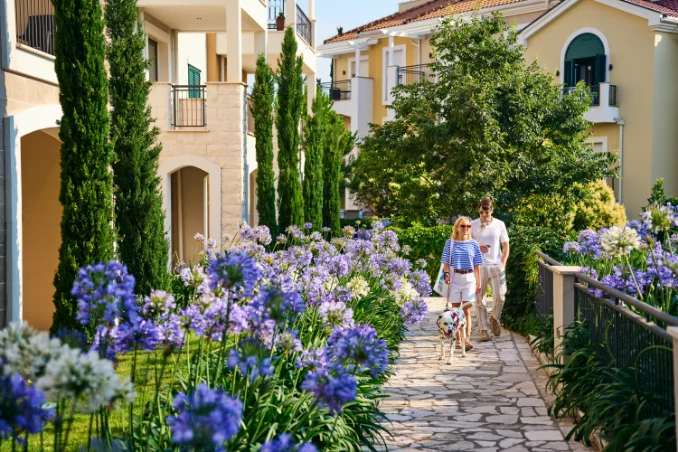
Premier Accommodations
- – Varied Living Options: Lustica Bay provides a range of luxurious living accommodations including sophisticated apartments, spacious townhouses, and private rooms, all boasting direct views of the Adriatic Sea. The architecture ensures that each dwelling not only offers comfort but also maximizes the stunning vistas.
- – Pet-Friendly Environment: Recognizing the importance of your furry friends, Lustica Bay offers pet-friendly accommodations and amenities, ensuring a welcoming environment for all family members.
Family and Leisure Amenities
- – Family-Oriented Facilities: The development is designed with family safety and enjoyment in mind. Child-friendly features include playgrounds, kids’ clubs, and regular kid-centric events, along with professional babysitting services to ensure that all family members, regardless of age, have an enjoyable and safe experience.
- – Outdoor and Indoor Recreation: Residents and guests can enjoy spacious balconies, community pools, and beautifully maintained green areas and gardens that enhance the living experience and provide ample space for relaxation and leisure.
Sports and Activities
- – Sports Facilities: Lustica Bay is equipped with a variety of sports facilities including courts for basketball, volleyball, tennis, and padel. During the summer months, a golf driving range is available, along with classes and activities like bootcamp and yoga, catering to all levels of fitness and interest.
- – Beach and Water Activities: The community includes access to four pristine beaches and exclusive beach and sea lounges, perfect for soaking up the sun or enjoying a variety of water sports.

Social and Cultural Life
- – Nightlife and Events: Lustica Bay offers a vibrant nightlife scene with a variety of events that cater to diverse tastes and interests. From live music and entertainment to cultural festivals and dining experiences, the community ensures a rich and varied social life.
- – Community and Connectivity: The emphasis on creating a connected and engaged community is evident in the range of events and activities designed to bring people together and foster a sense of belonging.
BOOK AN APARTMENT IN LUSTICA BAY
Take advantage of our special offers to experience Montenegro this summer. Enjoy the beautiful sunny weather, an abundance of blooming plants, the absence of tourist crowds, and warm evenings at restaurants on the Marina Village or Centrale waterfront — all of which will make your stay peaceful and filled with positive experiences. Our team will help you find the perfect accommodation option and make your stay in Lustica Bay unforgettable.
LEARN MORE ABOUT MONTENEGRO
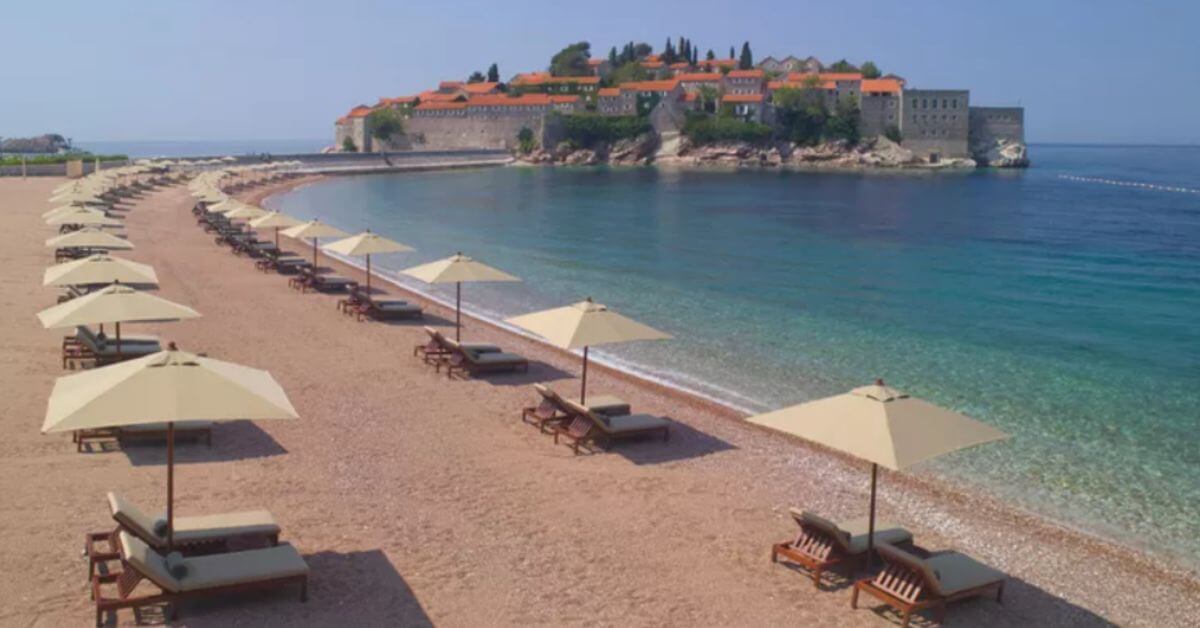 |
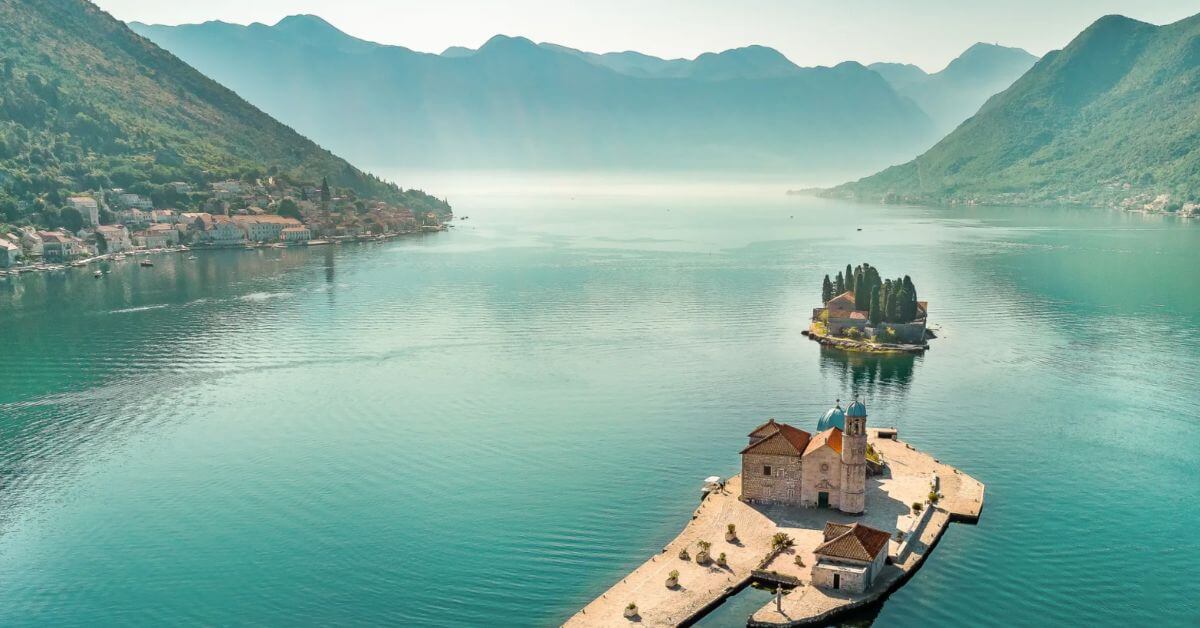 |
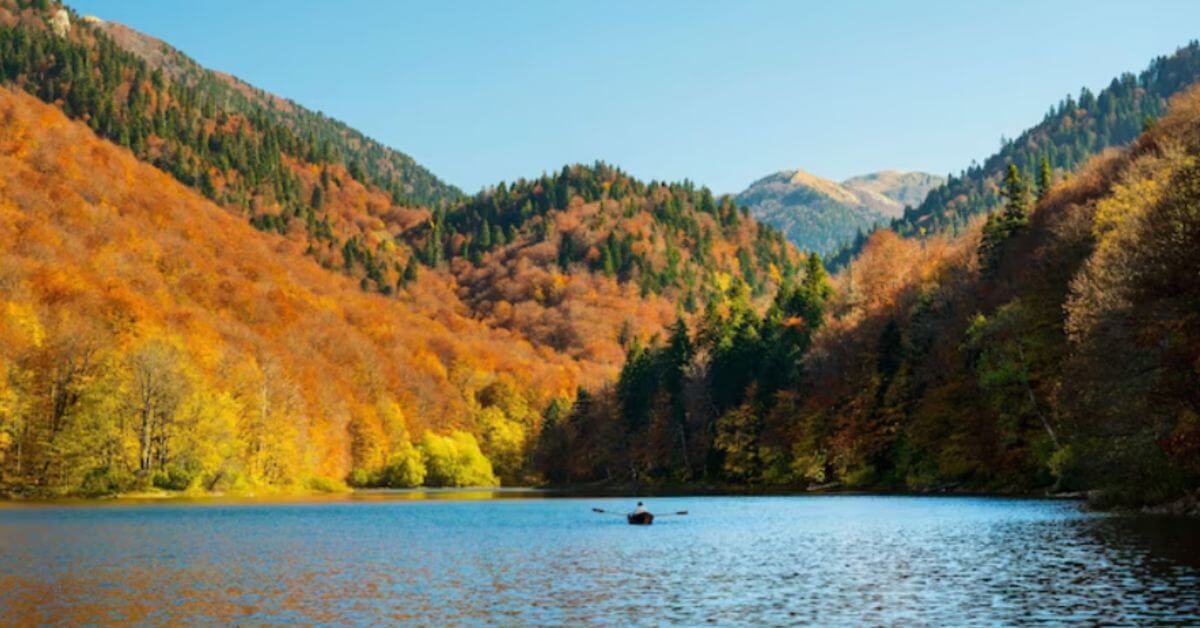 |
 |
 |
 |
| This Dreamy Coastal Road Trip in Montenegro Includes Charming Small Towns, Gorgeous Beaches, and Storybook Architecture | An insider’s guide to Montenegro, Europe’s up-and-coming summer hotspot | How to plan an epic road trip through Montenegro, the jewel of the Balkans |


